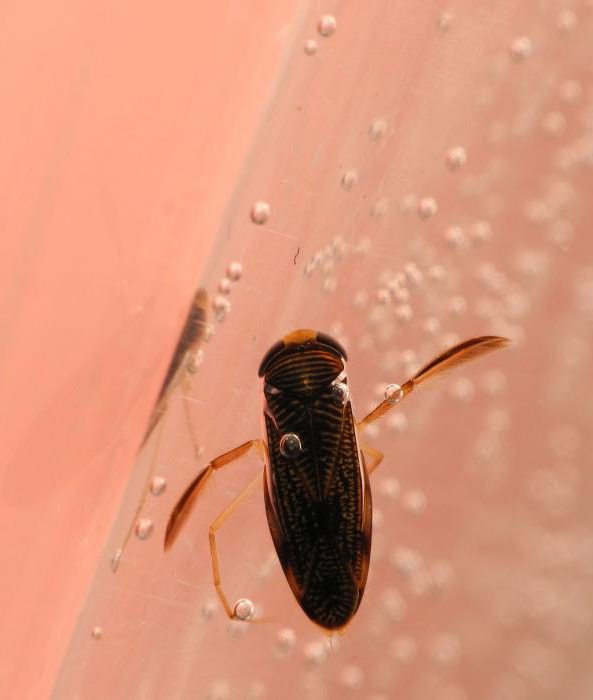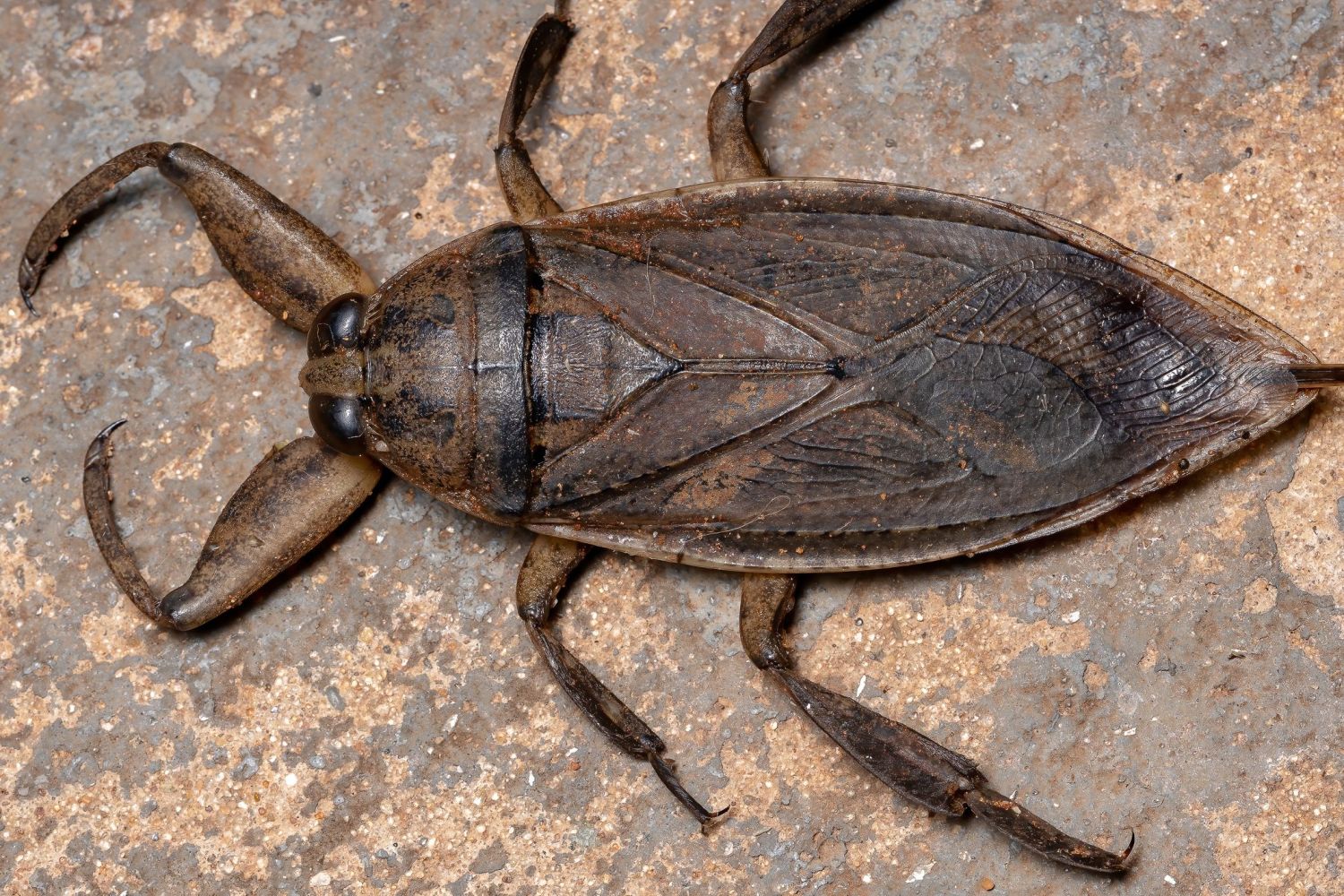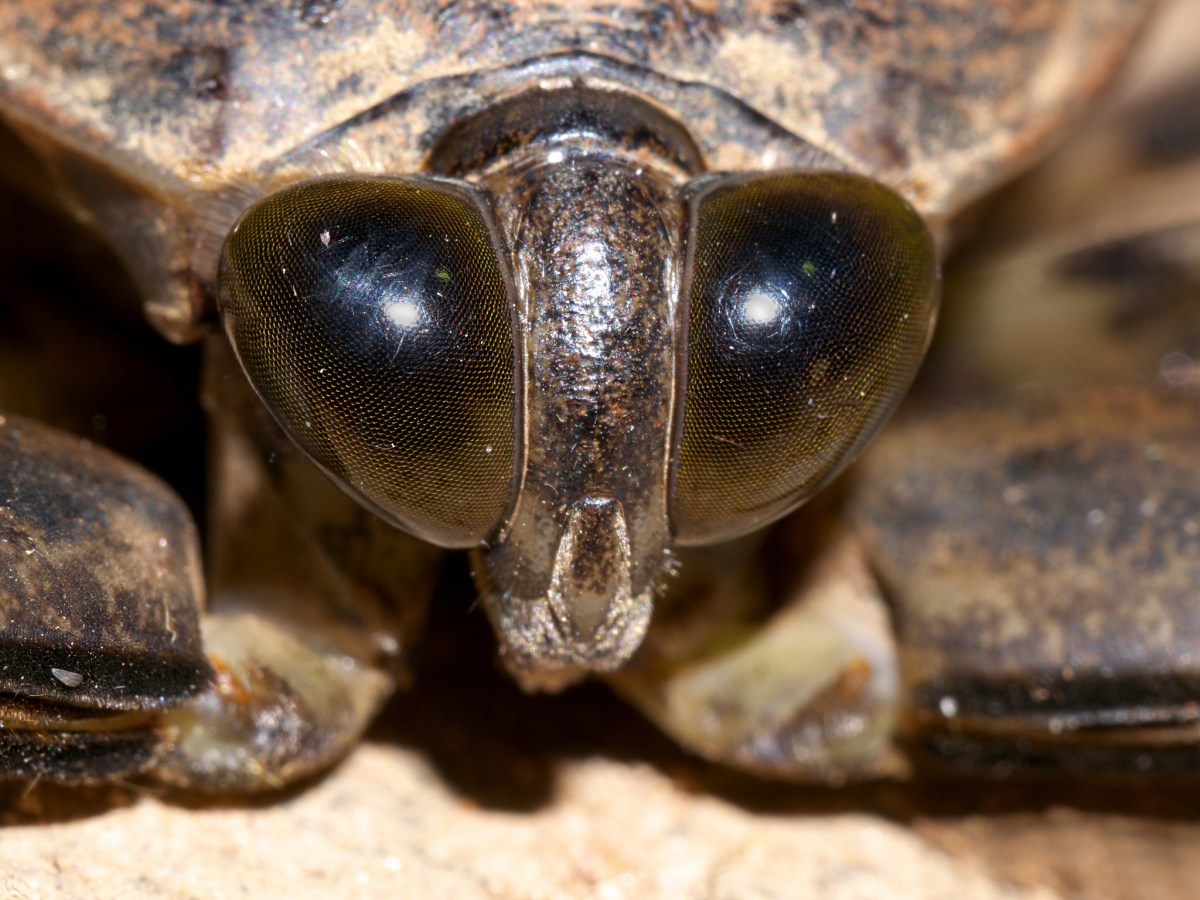True bugs, or Hemiptera, represent the largest separation of insects with incomplete transformation in the life cycle (incomplete metamorphosis). In total, the group has more than 30,000 species. They are distributed all around the world and live in all environments of existence.
We will meet three insect families: water boatmen, backswimmers, and giant water bugs. They are freshwater inhabitants. Of particular interest is the giant water bug, which we will discuss in greater detail.
Class Insects, Order Hemiptera

These insects got their name due to the presence of the front pair of wings, which differ in structure from the pair of rear ones. The forewings turned into elytra with varying degrees of stiffness (chitinization) and looked like transparent membranes with a multitude of veins. The group includes 50 families, but only three have adapted to living in an aquatic environment:
The largest family is the Water boatmen (Corixidae).
Backswimmers (Notonectidae).
Giant water bugs (Belostomatidae).
Representatives of these families have both similar and different features.
Oral Apparatus

The presence of a mouthpart characterizes all insects of this order. It has the shape of a nose, the base of which is a long segmented lower lip with a groove. In the groove are the lower and upper jaws, which have turned into long thin bristles. At the top, this apparatus is covered with a short upper lip. The structure of the oral apparatus determines the way the insects feed.
They all pierce the victim with their upper jaw cover and inject toxins into their body that paralyze prey and dissolve soft tissues. The entire oral apparatus is used, so the liquid contents of the victim are sucked in. Representatives of our three families are active predators, and their nostrils are short and curved, like the beaks of birds.
Other Common Features

Aquatic insects, unlike their companions, have no olfactory glands or are very poorly developed (in the case of a giant water bug). They inhale atmospheric oxygen through tracheal tubes that penetrate the entire body of the insect and spiracles that open in the chest or abdomen.
These insects reproduce sexually, and the female lays 10 to 200 eggs. They have a life cycle development - with incomplete transformation. The larvae hatch from eggs, very similar to adults. They molt 4-5 times, increasing in size and acquiring adult organs that larvae do not have (wings, antennae, paw segments).
After a few weeks, the larva turns into an imago. A feature of egg bugs is the presence of a cap on top. When the larvae open these caps but still don't come out of the egg, this scene looks pretty funny.
Water Boatmen Bugs

The family has about 600 species. These are little bugs. The largest representative reaches 16 mm. They live mainly in standing fishponds, feeding on algae and larvae of other insects. They are great at flying. Their distinctive feature lies in the structure of the limbs - they are all different. The first pair is a short shoulder blade, with male representatives with spikes. It's its musical apparatus - it carries them through the trunk in the water, and it turns out to be a pretty loud chatter.
The other pair is thin and long, with claws at the end. They cling to the algae, providing self-support. The third pair – has straight oars, through which the bug swims quickly. The female fixes the eggs on the algae with special glue, and they look like a small gray pile.
Interestingly, there are so many of these bugs in the Mexican lakes and swamps, so many were imported into Britain in poultry feed barrels in the last century. Up to 250 million individuals can be put in one barrel. After all, insects are pure protein!
Ordinary Water Bug

This representative of the bug family is typical on freshwater bodies of Russia (there are a total of 7 representatives of the species). The length of the imago is 1.5 cm, the body is green or brown in shape, similar in shape to an inverted ship. The peculiarity of a water bug is that it swims upside down and then becomes like a submarine. Breathing is carried through the tracheal tubes, which open in the abdomen.
The ordinary water bug is a favorite object of observation of young naturalists and is often planted in aquariums. From the surface, it carries underwater a bubble of air that looks like a bubble of mercury. They fly well and leave directly from the water, and the female lays eggs on the algae. But if you take it carelessly in your hands, the sting of a proboscis will be painful. However, it is not at all poisonous to humans.
Lethocerus Americanus: Giant Water Bug

In the fauna of the Russian Federation, two species live in the Far East, and the sizes are more than modest - up to 4-5 centimeters. The Far Eastern type hibernates for the winter, and the rest of the time, it runs the land-water mode. But actual giant water bugs live in warm and humid tropical countries (South and North America, Thailand, India). In Florida (USA), they are called alligator ticks, and in India, they are called toe biters.
Giant Water Bug: A Description

Let's start with sizes. These insects grow to a length of 17 cm. The colors are different - from green to brown - depending on the place of residence. In these bugs, the front legs (or the first pair) turned into powerful tick hooks. They are the ones who hold their prey firmly before injecting the toxin. They are active predators, primarily aquatic. Fish, frogs, and even turtles - that's what a giant water bug insect eats. It even attacks tiny water birds!
The toxin in the giant water bug saliva is similar in composition and action to the venom of some snakes, but it is not as venomous. It paralyzes the victim and dissolves its tissues, and the giant water bug sucks up the liquid contents. In hunting, these predators are aided by the reticular eyes and the auditory organ in the central part of the body (the temporal organ).
The giant water bug is also known to love the light of lanterns. That's why they are called "electric light bugs." In the light, people catch them in large quantities.
Breathing is performed through two tracheal tubes that open at the abdomen. These creatures have to float every 7-8 minutes to breathe. In case of danger, the giant water bug pretends to be dead. It becomes similar to a falling leaf, which can burst into the attacker with the secretion of olfactory glands located in the abdomen.
Caring Dad

The peculiarity of the giant water bug is the touching care for the offspring. And the male does it. The female holds up to 100 eggs (can lay up to 4 eggs at a time, so the bugs are forced to mate multiple times and spend a lot of time together). The new eggs are laid on the male elytra and stay for two long weeks on the tank's surface (as children need oxygen). At that time, the male eats less and becomes easy prey for other predators.
The male warms the eggs, sometimes moving its wings to aerate them. When the larvae open the egg lids for hatching, they do not leave the parent immediately. And the male continues to feed them. It is the only type of bug that shows such care for its offspring.
A New Species Of Insects!

It's a message that has recently rounded up the internet. This was accompanied by eerie photos and comments that after being bitten by a giant water bug, the person goes insane for two hours and dies.
These claims are then accompanied with a suggestion that you need to follow a link and buy an antidote. Resourceful fraudsters never cease to surprise us. Is the giant water bug that dangerous to humans? It can bite if you step on it or take it in your hands. It is painful but not deadly except for the nasty wound, which will heal within one to two weeks, be sure that the giant water bug causes no additional trouble.
A Gastronomic Treat

In Vietnam, giant water bugs are a precious resource. The male giant water bug gets caught as it collects the liquid from the production bags with pheromones. Ca'Cuong is the name of a product that has already entered the world market. One drop of this substrate changes the taste of food and, according to the Vietnamese, has a very beneficial effect. You know what.
In Thailand, these insects are simply fried - it is a common dish for locals. It's called Maeng da Na, it's sold in all markets, and it's cheap. Maybe there isn't a tourist who hasn't tried a giant water bug.
But in the Philippines, they remove the legs from these insects and make liqueur canapes. And they are fried whole and ground with garlic, tomatoes, onions - in general, with some flavoring. And they eat it with pleasure.
But in Japan, the male giant water bug symbolizes caring fatherhood, and it is respected and even written about. And they don't eat it there - in Japan, these creatures are listed in the Red Book with the status "on the verge of extinction."
Value For The Ecosystem

In every ecosystem, everything is connected and forms a "food-consumer" chain. And if these fantastic inhabitants appear in their natural environment, it means that someone needs it. These insects are an important link in the food chain. They reduce the number of larvae of mosquitoes, gadflies, and other insects.
In Vietnam, belostoma regulates the number of turtles with three keels - the primary pest of commercial fish. But the balance of benefits/harms here is very vague. After all, insects can cause significant damage to fish farming if they eat fish.
So, is the giant water bug dangerous to humans? No, and there is no reason for you to be afraid of it.



